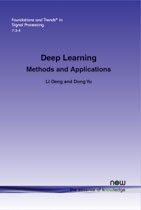Deep Learning: Methods and Applications
By Li Deng, Microsoft Research One Microsoft Way, USA, deng@microsoft.com | Dong Yu, Microsoft Research One Microsoft Way, USA, Dong.Yu@microsoft.com
Abstract
This monograph provides an overview of general deep learning methodology and its applications to a variety of signal and information processing tasks. The application areas are chosen with the following three criteria in mind: (1) expertise or knowledge of the authors; (2) the application areas that have already been transformed by the successful use of deep learning technology, such as speech recognition and computer vision; and (3) the application areas that have the potential to be impacted significantly by deep learning and that have been experiencing research growth, including natural language and text processing, information retrieval, and multimodal information processing empowered by multi-task deep learning.
Deep Learning
Deep Learning: Methods and Applications provides an overview of general deep learning methodology and its applications to a variety of signal and information processing tasks. The application areas are chosen with the following three criteria in mind: (1) expertise or knowledge of the authors; (2) the application areas that have already been transformed by the successful use of deep learning technology, such as speech recognition and computer vision; and (3) the application areas that have the potential to be impacted significantly by deep learning and that have been benefitting from recent research efforts, including natural language and text processing, information retrieval, and multimodal information processing empowered by multitask deep learning.
Deep Learning: Methods and Applications is a timely and important book for researchers and students with an interest in deep learning methodology and its applications in signal and information processing.
"This book provides an overview of a sweeping range of up-to-date deep learning methodologies and their application to a variety of signal and information processing tasks, including not only automatic speech recognition (ASR), but also computer vision, language modeling, text processing, multimodal learning, and information retrieval. This is the first and the most valuable book for "deep and wide learning" of deep learning, not to be missed by anyone who wants to know the breathtaking impact of deep learning on many facets of information processing, especially ASR, all of vital importance to our modern technological society." – Sadaoki Furui, President of Toyota Technological Institute at Chicago, and Professor at the Tokyo Institute of Technology
